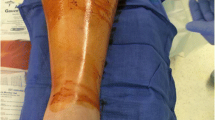Abstract
We prospectively studied 44 patients treated with the AO Unreamed Tibial Nail (UTN) at two orthopaedic trauma units. There were 15 open fractures: eight type I, four type II, one type IIIA, and two IIIB (Gustilo). The mean follow-up time was 13 months (range 6–24 months). There were 14 type A, 26 type B and four type C fractures (AO classification, Muller). All patients with the open fractures had surgery within eight hours of injury. Closed fractures were treated on the next available trauma list. The mean time to fracture union was 15.3 weeks (range 10-26). In the closed fracture group (n=29), the mean time to union was 14.9 weeks compared to 18.6 weeks for the open fracture group. There were no non-unions and no infections. One patient had a malunion and breakage of locking bolts occurred in two cases. Our results indicate that the UTN provides excellent results in the treatment of both closed and open fractures of the tibial shaft, with union times comparable to reamed techniques.
Similar content being viewed by others
References
Rhinelander, F. W. Tibial blood supply in relation to fracture healing. Clin. Orthop. 1974; 105: 1652–1659.
Klein, M. P. M., Rahn, B. A., Frigg, R., Kessler, S. et al. Reaming versus non-reaming in intramedullary nailing: interference with cortical circulation of the canine tibia. Arch Orthorop. Trauma Surg. 1990; 109: 314–316.
Swanson, T. V., Spiegel, J. D., Sutherland, T. B., Bray, T. J. et al. A prospective comparative study of the Lottes nail versus external fixation in open tibial fractures. Orthop. Trans. 1990; 14: 716–717.
Holbrook, J. L., Swiontkowski, M. F., Sanders, R. Treatment of open fractures of the tibial shaft. Ender nailing versus external fixation. J. Bone Joint Surg. 1989; 75-B: 845–847.
Caudle, R. J., Stern, P. J. Severe Open fractures of the tibia. J. Bone Joint Surg. 1987; 69-A: 801–807.
Karlstrom, S. B., Olerud, S. Fractures of the tibial shaft - a critical evaluation of treatment alternatives. Clin. Orthrop. 1974; 105: 82.
Kretteck, C., Haas, N., Tscherne, H. Behandlungsergebrisse von 202 frischen unterschkelfracturen, versorgy mit einem unilateralen fixateur externe. Unfallchirug 1989; 92: 440–452.
Haas, N., Krettek, C., Schandelmaier, P., Frigg, R. et al. A new solid unreamed tibial nail for shaft fractures with severe soft tissue injury. Injury 1993; 24: 49–54.
Melcher, G. A., Ryf, C. H., Leutenegger, A., Reudi, T. Tibial fractures treated with the AO unreamed tibial nail. Injury 1993; 24: 407–410.
Muller, M. E., Nazarian, S., Kich, P. Classification AO des fractures. Berlin, Heidelberg, New York: Springer-Verlag, 1987.
Winquist, R. A., Hansen, S. T, Clawson, D. K. Closed intramedullary nailing of femoral fractures. A report of five hundred and twenty cases. J. Bone Joint Surg. 1984; 66-A: 529–539.
Gustilo. R. B., Mendoza, R. M., Williams, D.N. Problems in the management of type III (severe) open fractures. A new classification of type III open fractures. J. Trauma 1984; 24: 742–746.
Kuntscher, G. B. The Kuntscher method of intramedullary fixation. J. Bone Joint Surg. 1958; 40-A: 17–26.
Velazco, A., Whitesides, J. R., Fleming, L. L. Open fractures of the tibia treated with Lottes Nail. J. Bone Joint Surg. 1980; 65A: 879–885.
Hassenhuttl, K. The treatment of unstable fractures of the tibia and fibula with flexible medullary wires. J. Bone Joint Surg. 1981; 63-A: 921–931.
Hamza, K. N., Dunkerley, G. E., Murray, C. M. Fractures of the tibia. A report on fifty patients treated by intramedullary nailing. J. Bone Joint Surg. 1971; 53-B: 696–700.
Klemm, K. W., Bonner, M. Interlocking of complex fractures of the femur and tibia. Clin. Orthop. 1986; 212: 89–100.
Bone, L. B., Johnson, K. D. Treatment of tibial fractures by reaming and intramedullary nailing. J. Bone Joint Surg. 1986; 68-A: 877–887.
Chapman, M.W. The role of intramedullary fixation in open fractures. Clin. Orthop. 1986; 212: 26–34.
Kessler, S. B. Hallfeldt, K. K., Perreu, S. M., Schweiberer, L. The effects of reaming and intramedullary nailing on fracture healing. Clin. Orthop. 1986; 212: 18–26.
Court-Brown, C. M., Christie, J., McQueen, M. Closed intramedullary tibial nailing. Its use in closed and type I open fractures. J. Bone Joint Surg. 1990; 72-B: 605–611.
O’Beirne, J., Seigne, P., McElwain, J. P. Interlocking intramedullary nailing for the treatment of tibial fractures. Ir. J. Med. Sci. 1992; 161: 5–8.
Riemer, B. L., DiChristiana, D. G., Cooper, A., Sagiv, S. Nonreamed nailing of tibial diaphyseal fractures in bunt polytrauma patients. J. Orthrop. Trauma 1995; 9: 66–75.
Whittle, A. P., Wester, W., Russel, T. A. Fatigue failure in small diameter tibial nails. Clin. Orth. 1995; 315: 119–128.
Tornetta, P., Bergman, M., Watrick, N., Berkowitz, Cr. Treatment of grade III open tibial fractures. A prospective randomised comparison of external fixation and non-reamed locked nailing. J. Bone Joint Surg. 1993; 75-B: 13–1.
Author information
Authors and Affiliations
Rights and permissions
About this article
Cite this article
Harrington, P., Sharif, I., Smyth, H. et al. Unreamed nailing of tibial fractures — a prospective study of the routine use of the unreamed tibial nail. I J M S 165, 282–285 (1996). https://doi.org/10.1007/BF02943091
Issue Date:
DOI: https://doi.org/10.1007/BF02943091




